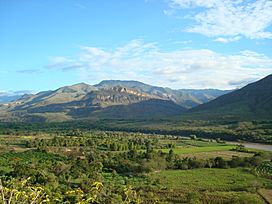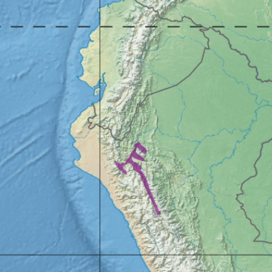Marañón dry forests facts for kids
Quick facts for kids Marañón dry forests (NT0223) |
|
|---|---|

River valley near Tactago in Cumba District
|
|

Ecoregion territory (in purple)
|
|
| Ecology | |
| Realm | Neotropical |
| Biome | Tropical and subtropical dry broadleaf forests |
| Geography | |
| Area | 11,396 km2 (4,400 sq mi) |
| Countries | Peru |
| Coordinates | 5°56′S 78°40′W / 5.94°S 78.67°W |
| Climate type | Cfb: warm temperate; fully humid; warm summer. |
The Marañón dry forests (NT0223) is a special natural area in northern Peru. It covers the lower valley of the Marañón River and its smaller rivers. This area is along the eastern side of the Andes mountains. It has a dry climate. This is because tall mountains to the east block the rain.
People have used this land for a long time. They have done farming, raising animals, and cutting down trees. Now, new dams for electricity and watering farms might change this special place.
Contents
Where are the Marañón Dry Forests?
This dry forest area is in northwestern Peru. It covers about 1.1 million hectares (about 2.8 million acres). It stretches along the upper valley of the Marañón River and its smaller rivers.
To the north, this area meets the Eastern Cordillera Real montane forests. The northern part of the dry forests connects to the Tumbes–Piura dry forests in the west. It also connects to the Ucayali moist forests in the east. Further southeast, it extends through the Peruvian Yungas and parts of the Cordillera Central páramo.
Land and Rivers of the Marañón
The Marañón River starts from the Nevado de Yapura glacier. It flows northwest through northern Peru. It runs between the western and eastern mountain ranges of the Andes. Then, it turns northeast and breaks through the mountains. It flows into the Amazon lowlands. There, it meets the Ucayali River and together they form the mighty Amazon River.
The southernmost part of this dry forest area is in the Tayabamba District. This is west of the Rio Abiseo National Park. The dry forests continue downstream along the river valley. They go northwest to the region south of Jaén. Here, the Chamaya River joins the Marañón, and the river turns northeast.
The area also includes the valley of the Chotano River. This river flows northwest, parallel to the Marañón. The Chotano joins the Huancabamba River to form the Chamaya River. This happens below Pucará. The Chamaya then flows northeast to join the Marañón. Beyond Jaén, the dry forests follow the southeast bank of the Marañón. They also include the valleys of the Utcubamba and Chiriaco rivers. These rivers flow into the Marañón from the southeast. The eastern part of Cordillera de Colán National Sanctuary is also in the Chiriaco valley.
Climate in the Dry Forests
The Marañón dry forests have a dry climate. This is because mountains to the east block the rain. The climate is described as "Cfb". This means it is warm temperate, fully humid, and has warm summers.
The valleys of the Utcubamba, Chamaya, and Marañón rivers have similar weather.
- At higher elevations (above 700 meters or 2,300 feet): The average yearly temperature is about 25 degrees Celsius (77 degrees Fahrenheit). The average yearly rainfall is between 567 and 1,019 millimeters (22 to 40 inches).
- At lower elevations (below 600 meters or 2,000 feet): The average yearly temperature is about 24 degrees Celsius (75 degrees Fahrenheit). The average yearly rainfall is between 162 and 793 millimeters (6 to 31 inches).
In a sample spot, the average yearly temperature is about 15 degrees Celsius (59 degrees Fahrenheit). The lowest average is 7 degrees Celsius (45 degrees Fahrenheit). The highest average is 23 degrees Celsius (73 degrees Fahrenheit). The average total rainfall is about 670 millimeters (26 inches). Rainfall changes throughout the year. It is lowest in July (about 7 millimeters or 0.3 inches). It is highest in March (about 108 millimeters or 4.3 inches).
Ecology and Wildlife
The Marañón dry forests are part of the Neotropical realm. This is a large natural area that includes Central and South America. The forests are a type of tropical and subtropical dry broadleaf forests.
This ecoregion is part of a larger area called the Tumbesian-Andean Valleys Dry Forests. This bigger area covers about 103,000 square kilometers (about 40,000 square miles). It includes six other dry forest areas. Many plants and animals found here are unique to this region.
Plants of the Marañón Dry Forests
The Marañón dry forests have different types of plant life. You can find seasonally dry tropical forests where trees lose their leaves. There are also dry or riverside scrublands. This area is very rich in plants, especially for an inter-Andean valley. It has 184 types of woody plants.
Some common trees and plants include Acacia macracantha, Ceiba insignis, and Hura crepitans. Many plants are found only in Peru (69 species). Some are found only in small, separate areas. These include Browningia riosaniensis and Praecereus euchlorus. Scientists have also recently found new species like Parkinsonia peruviana. They even found a new group of plants called Maraniona.
Animals of the Marañón Dry Forests
The Marañón dry forests are home to many unique animals. Some amphibians, like the painted frog (Atelopus pachydermus), are endangered.
Birds are very special here. There are 22 bird species that live only in a small area. Eleven of these are found nowhere else in the world. Endangered birds include the yellow-bellied seedeater (Sporophila nigricollis) and the Marañón spinetail (Synallaxis maranonica).
Current Challenges
People have used this area for a long time. They have done farming, raised cattle, and cut down trees. This has changed the natural environment.
In 2011, plans were announced to build many dams on the Marañón River. There could be as many as 20 dams for electricity and watering farms. Many of these dams would be in sensitive natural areas, like the dry forests. Building these dams could also mean that local people, farmers, and fishermen living along the river would have to move.
See also
 In Spanish: Bosque seco del Marañón para niños
In Spanish: Bosque seco del Marañón para niños
Images for kids



